Iranian Saffron
Saffron history
Human cultivation and use of saffron spans more than 3,500 years and extends across cultures, continents, and civilizations. Saffron, a spice derived from the dried stigmas of the saffron crocus (Crocus sativus), has through history remained among the world’s most costly substances. With its bitter taste, hay-like fragrance, and slight metallic notes, the apocarotenoid-rich saffron has been used as a seasoning, fragrance, dye, and medicine.
Saffron application
Saffron has many applications in various industries due to its many properties, including: food industry, pharmaceutical industry, cosmetics industry and textile industry. The natural and very high coloring power of saffron, which is due to the substance “crocin”, has led to the substitution of synthetic dyes in many countries in the quality food industry. Saffron is used in a variety of foods such as meat, poultry, fish, rice, stew, soups, pastries, biscuits, ice cream, syrups, and especially tea and many other foods due to its beautiful color, aroma, and flavor. Consumption of a cup of saffron tea or saffron syrup relieves fatigue. Among the properties of saffron, it is known to be invigorating and very effective for relieving depression and anxiety. The use of saffron as a food seasoning or brew leads to better absorption of its effective compounds in the body and thus receiving useful elements such as calories, carbohydrates, protein, fiber, iron, phosphorus, calcium, sodium and potassium.
Saffron’s chemical composition
Saffron contains more than 150 compounds (volatile and non-volatile) including carotenoids (crocetin, crocin, β-carotene, lycopene, and zeaxanthin), monoterpene aldehydes (picrocrocin and safranal), monoterpenoids, and isopherones. However, it also contains other compounds such as flavonoids, vitamins, proteins, and amino acids. Saffron owes its sensory and functional properties mainly to the presence of its carotenoid derivatives, synthesized throughout flowering but also during the whole production process. These compounds include crocin, crocetin, picrocrocin, and safranal, which are the secondary or bioactive metabolites. Saffron’s quality depends on its chemical profile and is directly related to the geographic area, climate variability, environmental practices, genetic traits, soil composition, cultivation conditions, and processing and storage methods.
What are saffron health benefits?
Saffron, derived from the Crocus Sativus flower, brings many health benefits to its consumers. This expensive spice already has many medicinal uses for different purposes. The saffron has an integral role in some Asian cultures, such as India, Iran, Vietnam, China, and many more, for its healing properties. Nowadays, organic products and drugs have become trendy and have found more popularity among producer companies and consumers. As a result of this organic trend, saffron has become an inevitable ingredient in cosmetics and health products.
Saffron is benefit for:
- Skin
- Depressive symptoms
- Cancer
- Sleep
- Weight loss
- Mental Health
- Immunity system
- PMS symptoms
- Heart diseases
- Eyesight
Surely, saffron pharmaceutical and medicinal benefits are not limited to the ones mentioned in above. The regular consumption of saffron is influential in decreasing the spread of viral diseases, such as colds, flu, and even Covid-19. In addition to that, saffron can regulate the digestive system as well as treat in-delayed puberty.we tried to cover some of the main saffron health benefits. However, the list of saffron health benefits can be so much more than what we covered.
FAQ
Is saffron good for hair growth?
Saffron contains certain compounds, such as antioxidants and anti-inflammatory properties, that may be beneficial for hair growth.
Does saffron work immediately?
Saffron does not work immediately. Saffron benefits appear only if it is used regularly at safe dosages.
When should we avoid saffron?
Saffron should be avoided during pregnancy, breastfeeding, in case of certain medicine interactions and certain health conditions. Remember to consult with your doctor about saffron consumption.
Does saffron really help ADHD?
Some studies investigated the effect of saffron on ADHD, and the results show positive effects of saffron on improving ADHD symptoms by using saffron supplements.
Different type of Iranian saffron
Iranian saffron is becoming more popular worldwide and is recognized for its superior quality. Persian saffron has long been renowned for its excellence and flavor. Although saffron cultivation is concentrated in a few Iranian provinces, Persian saffron accounts for over 90 percent of the global saffron supply. Currently, various types of saffron are exported to more than 53 countries. We provide a brief overview of different types of Iranian saffron.
The Iranian saffron types include:
- Super Negin saffron
- Negin Saffron
- Sargol Saffron
- Poushali or Filaments Iranian Saffron
- Bunch Iranian Saffron (or Filaments Grade 4)
- Ground or Powder Iranian saffron
- Konj or white Iranian saffron
There are two important factors, which highly affects the quality and types of saffron:
- Physical structure, which is maturity and the amount of red or white saffron
- Chemical parameters such as coloring, fragrance, and saffron taste power
These two factors, along with many more factors such as planting to harvest methods and conditions, different ways of stigma stripping, drying, and storing, have a great effect on the type and quality of saffron. In the rest, you will learn about different types of Persian saffron, called Zafaran locally.
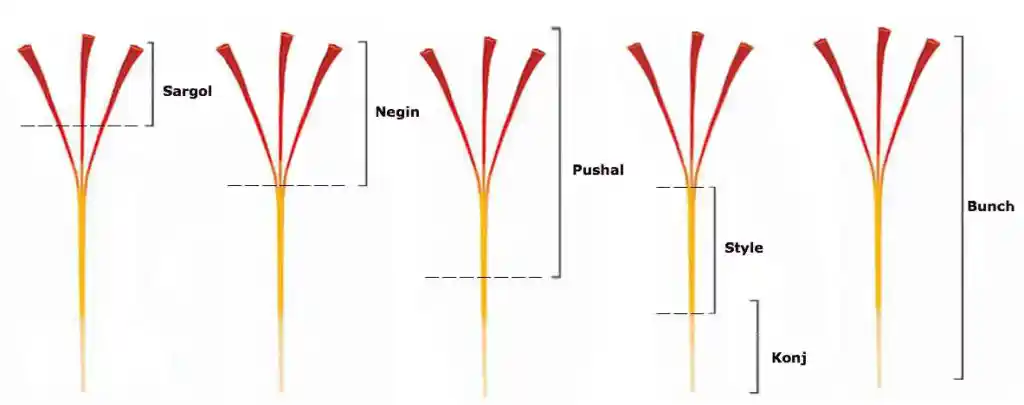
Full Red saffron
Full Red is one main category of Persian saffron, named so for its completely red look and absence of style. Full Red saffron consists of three subcategories: Sargol, Negin, and Super Negin.
Super Negin Iranian saffron
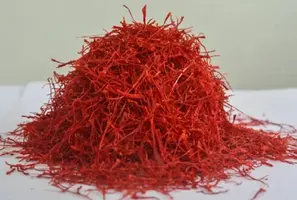
Super Negin Iranian saffron is the most potent and finest saffron type in the world. Super Negin, as the highest quality and luxurious saffron type, only includes long-flat and thick stigmas, without the yellow styles. Super Negin Saffron has the longest stigmas and the best appearance of all types. The stigmas are cut symmetrically, without any wave.
Super Negin is the most desired saffron for various uses, as it possesses great coloring power and aroma. Producing Super Negin Saffron is challenging and requires professional manual skills and the use of technical equipment compared to other types. Consequently, it demands more time and effort, making it the most expensive type among other Persian saffron varieties.
Negin Iranian saffron
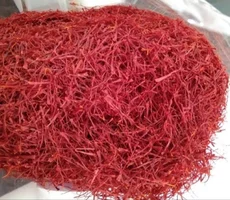
Negin Iranian saffron is ranked second in terms of quality and price. There is no difference between Negin and Super Negin, except for the length of the stigma and physical appearance.
In terms of appearance, Negin saffron is not long and flat, but it has the typical look of saffron threads. It is worth noting that Negin Saffron has a higher coloring power of over 220 USP. Due to its lower price compared to Super Negin, it is more popular for home use.
Features of Negin saffron:
- It only contains the red, long, stigmas of the saffron flower with few small broken stigmas.
- It is produced after complete separation of styles by natural or machine drying process.
- They differ in the size and thickness of the stigmas and their special drying methods and conditions, compared to Super Negin saffron.
Sargol saffron
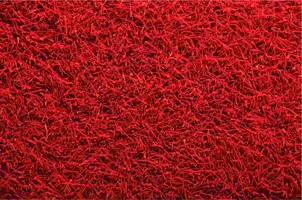
Sargol saffron is shorter in size in compared to Negin Type. In pure Sargol, the style is removed from red stigmas. Sargol Saffron and Negin saffron are alike in terms of quality and coloring power. Sargol saffron is derived from Poushal or filament saffron.
Poushal Iranian saffron
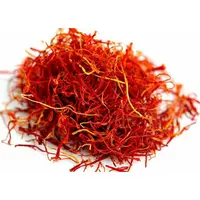
Poushal Iranian saffron, or Filaments saffron, includes red color stigmas with a 1-15 mm long creamy style. Farmers can yield about 1kg of Poushal from 80-100 kg of the saffron crocus flower. Depending on stigma size and thickness, Poushal or Filaments have less coloring power than Negin and Sargol types, as they contain styles.
Konj or white saffron
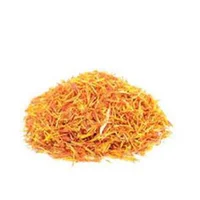
Konj or white saffron is the yellow style of saffron, with no red stigma. Konj saffron maintains more moisture because of its textual differences. However, the main worthy properties of saffron, such as Crocin, are hidden in red stigmas. Konj or white saffron has no coloring power, however; used for many purposes.